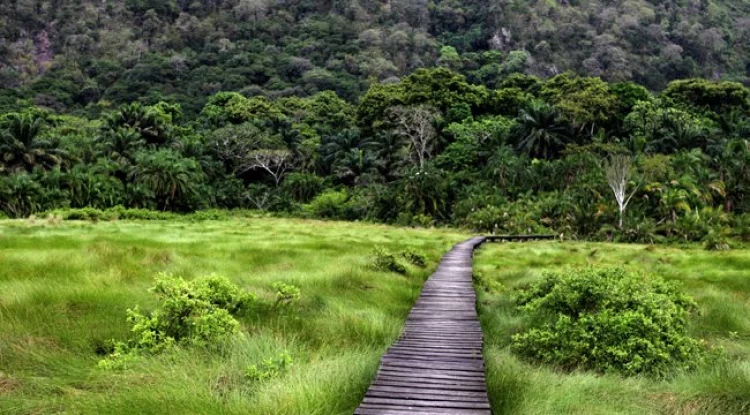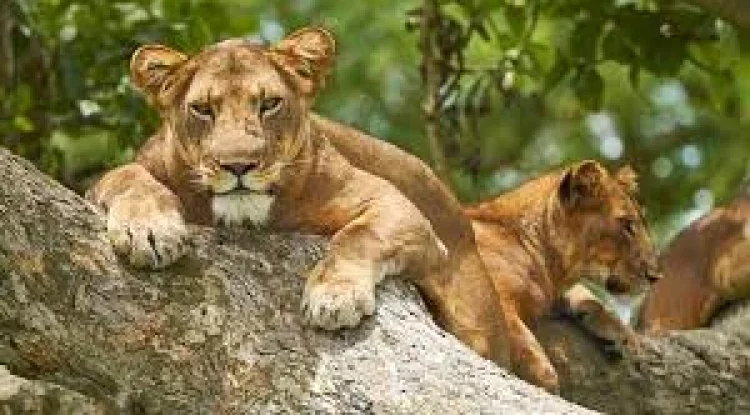Plan a Safari to Bwindi Impenetrable National Park
Bwindi Impenetrable National Park is one of the top national parks for adventures in Africa. The word ‘bwindi’ means ‘darkness’ and taking a hike in this magnificent forest will certainly show you the reason as to why the forest was named so. Without leaving out the local language, bwindi means impenetrable in Rukiga, a local language of the Bakiga People that live adjacent to the park. The national park is a home to many of the world’s leaves and fruits from the park’s many trees and fern species.

The location of Bwindi Impenetrable Forest Park.
Situated in the southwestern region of Uganda, Bwindi is famous for mountain gorilla safaris, an adventure activity that involves tourists hiking in the impenetrable jungle looking for the mountain gorillas that live on the higher slopes of the forest. This UNESCO World Heritage Site is shared by Rukungiri, Kabale, and Kisoro Districts. Under the skies of Bwindi forest lies a vast green rain forest that is home to almost half of the world’s remaining population of mountain gorillas! These great apes have called this place their natural home for many years!
The History of Bwindi Impenetrable Forest Park
The precious Bwindi Impenetrable National Park was gazetted into a national park in order to protect and conserve the wide range of species within the park and, most importantly, to protect and conserve the rare mountain gorilla. The declaration of the forest into a national park negatively affected the Batwa pygmy people, who were the traditional inhabitants of the forest. At that time, they were evicted from the forest without compensation, and they were not allowed to extract any forest resources. In the year 1993, gorilla tracking became a dominant tourist activity in the park, and the first gorilla group to be habituated for tourism purposes was the Mubare gorilla group, which was opened in the month of April, 1993. The opening of this group of mountain gorillas helped to fuel the number of gorilla safaris in Uganda.
Historically, in the year 1932, two important parts of the eco-diversified Bwindi Impenetrable Forest were named as Crown Forest Reserves; the northern block of the forest was considered as the “Kayonza Crown Forest Reserve," while the southern counter block of the forest was designated as the “Kasatora Crown Forest Reserve." The designated reserves had a total area of 207 square kilometers (80 sq mi). In the year 1942, the designated two forest reserves were amalgamated and renamed as the Impenetrable Central Crown Forest. The newly named area covered an estimated area of 298 square kilometers and was managed by the two bodies of the Ugandan government forest department and game department.
In the year 1964, the reserve was considered as an animal sanctuary, and this was done so as to provide more conservation and protection of the endangered mountain gorillas, which were rare and most wanted to trek by the visitors taking safaris in Uganda, and from then the name changed to Impenetrable Central Forest Reserve. In the year 1966, two vital forest reserves were added to form the main forest reserve, and this increased the total area covered by the central forest reserve to roughly 321 square kilometers (124 sq mi), and it was under the administration and management of the two bodies, i.e., game sanctuary and forest reserve.
The remarkable history of the park which no visitors mainly on Uganda gorilla safari and tour should not miss knowing is the one explained in the year 1991, when three forest reserves of Impenetrable Central Forest Reserve, as well as Mgahinga Gorilla Reserve and the popularly known Rwenzori Mountains Reserve were declared national parks and they renamed Impenetrable Forest Reserve to Bwindi Impenetrable National Park, covering an estimated area of 330.8 square kilometers (127.7 sq. mi).
QUICK FACTS
- The impenetrable forest covers around 331 square kilometers at an altitude range of 1160 meters (Ishasha gorge) to 2607 meters (Rwamanyonyi Peak).
- The annual average temperature range is 7–20 degrees Celsius, with the coldest period being June and July.
- The heaviest rains are experienced in March-April and September-November. Other months are generally dry.
- Annual Precipitation: 1130 mm – 2390 mm Coldest Period: June-July
Getting There
Most gorilla safaris to Bwindi Impenetrable National Park start from either Kampala or Entebbe. Bwindi can be reached from QENP in the north (2–3 hours), from Kabale in the south (1-2 hours), or from Kampala via Mbarara (6–8 hours). The roads meet at Butogota, 17km from the Buhoma entrance gate. 4×4 recommended during the rains.
Traveling to Bwindi National Park by Land
Typically, travellers purchase private Uganda safari cars at the beginning or end of their safari. The journey to Bwindi National Park is long and rocky, giving you an African massage but also offering spectacular views. As a result, you'll need a four-wheel-drive safari car to get around in comfort. The rolling Kigezi hills, meandering rivers like the Ishasha River, Rwizi River, Munyanga River, Katonga River, and much more can all be seen along the trip. Some are nestled within the rolling hills' valleys, creating a lovely sight. Because the arrival time is usually in the evening, if you are going directly to Bwindi National Park, you must restrict your stopovers.
Flying to Bwindi National Park.
Most tourists who do not want to drive long distances have chosen fly-in gorilla trekking safaris. Various scheduled or charter flight companies fly into Kihihi and Kayonza Air Strips, and offer this service. However, the amount of baggage you can carry is limited, and you'll need a vehicle to transport you from the airport to Bwindi National Park. Because Bwindi Impenetrable National Park is a short distance from the landing air strip, a safari vehicle must be arranged to pick you up.
Activities in Bwindi Forest National Park
In Bwindi, there are numerous things to see and do. Of course, gorilla tracking is the park's main tourist attraction, but there are many other things to do and see in Bwindi Impenetrable National Park, including the Batwa experience, community excursions, hiking, waterfall visits, women's bicycle riding, nature walks, bird watching, volunteerism, and community retreats. All of the park's activities are entertaining and affordable in terms of the overall experience.

Gorilla trekking tours
Safaris with gorillas This is the most well-known tour adventure in Bwindi Forest, and for many Uganda safaris, it is the highlight. Each of the park's four sectors—Buhoma, Rushaga, Ruhija, and Nkuringo—offers gorilla trekking once every day. On a daily basis, the park has roughly ten habituated gorilla families ready for tourists, but due to high demand and competitiveness, booking your gorilla ticket is essential. Consider staying the night near the park if your gorilla walk is the next day. Tour of the Batwa People You'll only need an afternoon to learn about the Batwa people's unique culture after they left their ancestral land to protect mountain gorillas. They grew up in the tropical bush, where they were both born and nurtured.
Batwa Cultural Tour
You'll only need an afternoon to immerse yourself in the Batwa people's unique culture, which they left behind to protect mountain gorillas. They were born and nurtured in the rainforest forest of Bwindi National Park, where they lived with wildlife until park managers persuaded them to leave for mountain gorilla conservation, Uganda's most popular tourist attraction. Hunting, singing, dance, and theater, as well as Batwa shooting bow and arrow abilities and clothing code, are all old culture trends that will spark your interest.
Bwindi Community Walks and Retreats
Exploring the adjacent park communities, homesteads, hospitals, schools, and projects will take an afternoon or all day if time permits. Meet people of the community, learn about their traditions and customs, such as handcrafts, local beer, and locally roasted coffee, and get a glimpse into the lives of traditional healers who demonstrate the use of natural herbs to treat specific conditions. Retreats can also be held in schools and hospitals, making your stay even more memorable.
Bwindi Forest Walk.
This is another forest excursion for those who visit the park purposely to explore the jungle. Bwindi forest walks are great in the mornings and afternoons depending on the guests' wishes, though among the five forest walks in Bwindi, the most popular is the water falls hike, which involves some moderate hiking and climbing.
The Muyanga river trail is fantastic just outside the main park trekking areas and takes 30 minutes starting and ending in Buhoma. This trail is great for bird watchers; monkey and baboon warthogs, duikers, and much more can be seen. Also, checking out Mazubijiro loop trail and Rushara Hill trail will be amazing if time permits. For those interested in an all-day forest walk, the Ivo River walk for eight hours is simply the best.
What is the best time and period to visit Bwindi?
The dry months of June-October and December-March are well-known in Uganda and are unquestionably the ideal for any Uganda safari, including gorilla trekking in Bwindi Impenetrable Forest National Park. Tracking gorillas, on the other hand, is a year-round hobby that anyone can enjoy at their leisure. If you only have a limited amount of free time, make it a point to go on a 3-day/2-night gorilla safari tour and explore this magnificent jungle. Remember to take advantage of gorilla permit reductions in April, May, and November to save money for your next vacation.
General Bwindi Forest Trips
Typically, Bwindi National Park tour itineraries are flexible and tailored to the needs of the guests, so feel free to choose your own number of days and nights and enjoy your time in this incredible natural wonderland. At the time of booking, make sure to tell your travel coordinator about all of your tour interests.
Recommendations for Gorilla Trekking
If you're backpacking or going on a trek, pack light so you can hike and trek safely in the jungle. Wear suitable walking shoes, long-sleeved clothing, and bring a lunch box and enough of water, as the timing of the hike is determined by where the gorillas spend the night before your trek. Remember that they are wild animals looking for food in the jungle.
Accommodation facilities include:
Buhoma Community Rest Camp, Lake Kitandara Bwindi Gorilla conservation Camp for budget tourists, Nkuringo Gorilla Camp site, Bwindi volcanoes lodge, Engangi Camp Uganda for mid- range tourists and Silverback Lodge, Ruhija Gorilla Safari lodge, Mahogany springs camp for luxury tourists.
What's Your Reaction?
 Like
0
Like
0
 Dislike
0
Dislike
0
 Love
0
Love
0
 Funny
0
Funny
0
 Angry
0
Angry
0
 Sad
0
Sad
0
 Wow
0
Wow
0









































































